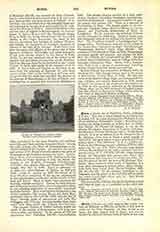

Elusa, a titular see of Palaestina Tertia, suffragan of Petra. This city is called Chellous in the Greek text of Judith, i, 9. It is also mentioned by Ptolemy, V, xv, 10 (in Iduma a), Peutinger’s “Table”, Stephanus Byzantius (as being formerly in Arabia, now in Palaestina Tertia), St. Jerome (In Isaiam, V, xv, 4), the pilgrim Theodosius, Antoninus of Piacenza, and Joannes Moschus (Pratum Spirituale, clxiv). In the fourth century, as is to be learned from St. Jerome’s life of St. Hilarion, there was at Elusa a great temple of Aphrodite; the saint seems to have introduced Christianity there (“Vita Hilarionis” in P.G., XXIII, 41). Early in the following century a Bishop of Elusa after redeeming the son of St. Nilus, who had been carried off from Mount Sinai by the Arabs, ordained both him and his father (P.G., LXXIX, 373-93). Other bishops known are Theodulus, 431; Aretas, 451; Peter, 518; and Zenobius, 536 (Lequien, Or. christ., III, 735). Today the ruins of the city are seen at El-KhalasƒÅ (Khalasah), about nineteen miles south of Bersabee, in a large plain belonging to nomad tribes. Many inscriptions have been found there (Revue Biblique, 1905, 246-48, 253-55). In the vicinity, according to the Targums, was the desert of Sur with the well at which the angel found Agar (Gen., xvi, 7). (See Revue Biblique, 1906, 597).
The ancient See of Elusa (Eauze) in Gaul was united with that of Auch (q.v.) probably in the ninth century.
S. VAILHÉ

